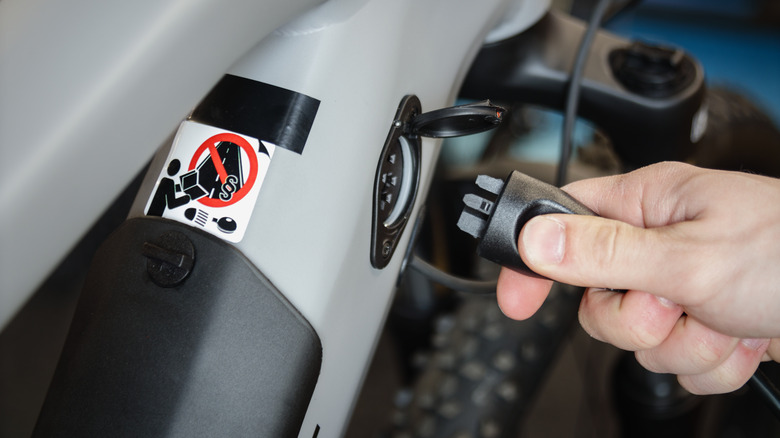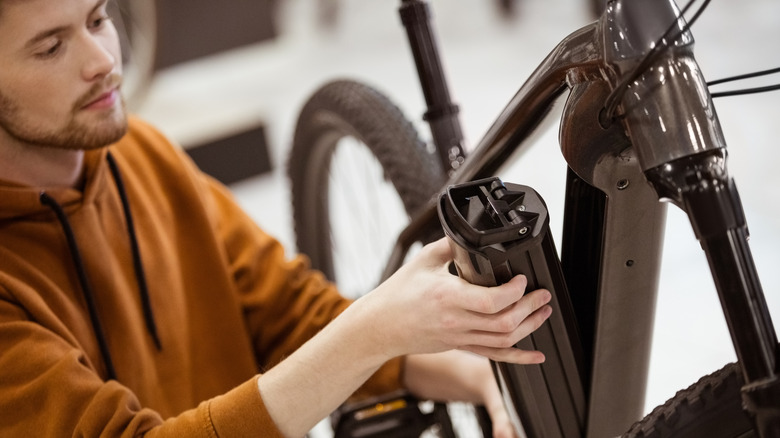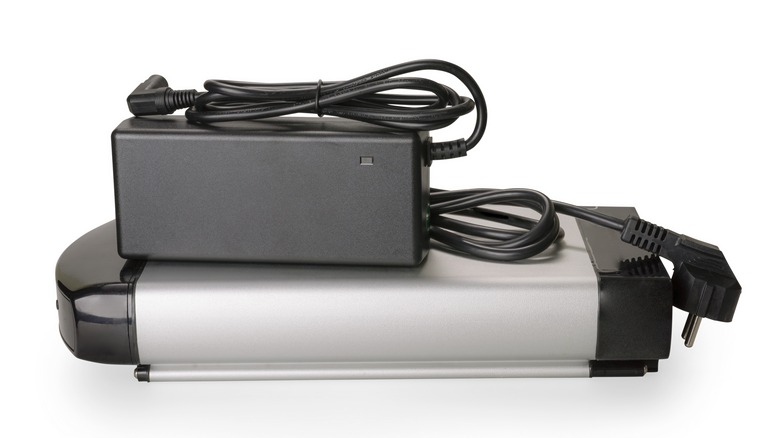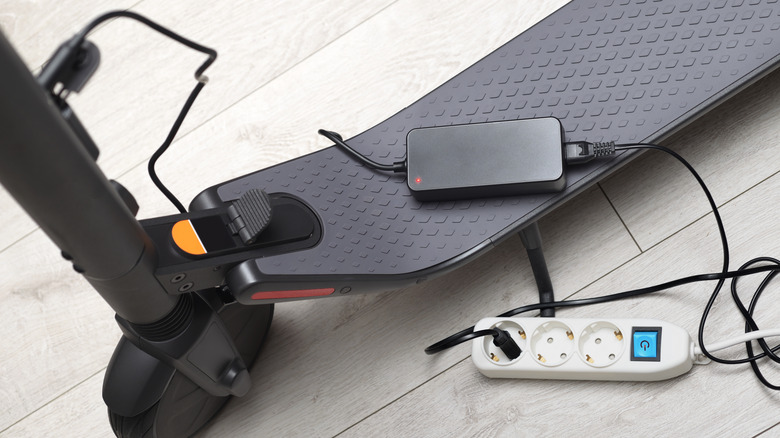You Might Be Charging Your Electric Scooter Or eBike Wrong, Here's The Right Way
If you regularly use an electric scooter or a bicycle with an attached electric motor (eBike), you're bound to be familiar with the need to charge it. This is typically just a matter of plugging it into a wall outlet, which is such a mundane action it doesn't need a detailed explanation. So, how is it possible to do it wrong?
Aside from the obvious errors nobody who's spent years with electronic devices is likely to make in modern times, there are some things we may do (either on occasion or as part of the regular charging routine) that would be considered incorrect. Worse than a mild sense of embarrassment, though, is the idea that a few of these accidental flubs could reduce the battery's overall lifespan — catching fire or even exploding isn't out of the question in extreme cases, either.
None of this necessarily means your personal electric conveyance is a ticking time bomb, but you should be mindful of that lithium-ion battery. As a general rule, you should always consult the user's manual for proper charging instructions and follow them to the letter to avoid potential mishaps. However, there are a few other things to keep in mind.
Where and how do matter
The location you decide to charge your device makes a difference, and not just for obvious things like rain. It's also highly recommended you do not charge in direct sunlight (or leave it in direct sunlight in general), as this can lead to severe overheating.
Similarly, the overall temperature of the room you charge it in matters — an environment that's either too hot (over 113 degrees Fahrenheit) or too cold (below 32 degrees) may damage the battery. You'll also want to avoid setting it too close to a major heat or cooling source, like an air conditioner, heater, or other big appliances that could radiate heat or cold.
You should also avoid leaving it to charge overnight, no matter how tempting a prospect that might be. This reduces the risk of accidentally overcharging your device, which can also lead to damage. However, some models are built to self-manage to avoid this particular situation. But even if you know yours does have such a failsafe, it's still best to manually unplug it once it's back up to full.
Most manufacturers also stipulate that you should plug your eBike or scooter in via a particular order of operations: plug the charger into the outlet first, then plug the charger into the device itself. This helps to protect the battery's capacitors and prolong its lifespan, but if the user manual says otherwise, follow that instead.
Mind the hardware
What you use to charge your eBike or scooter is also extremely important. Using the included charger and cables is always recommended, but these components can fail, break, or simply get lost over time. You're not out of luck if this happens, as replacements can be found, but you'll want to be very careful about anything not included in the original box.
If at all possible, source an official replacement from the same company. As tempting as it might be to grab an inexpensive third-party option or borrow a charger from another manufacturer, there are often a lot of minute differences in how these items handle electrical currents that could cause problems when used on a model they aren't intended for.
While it's not impossible to use a different, well-known, and trusted brand's charger with your device, you'll still want to do some digging before attempting to make sure it meets the proper voltage levels. (Consult the manual if you aren't sure.)
There's a little more leeway with battery replacement, though. Unlike chargers, replacing an old battery with one from a reputable source is generally much safer. However, you should still avoid unknown brands or suspiciously affordable listings for official batteries. These third-party (or possibly knock-off) options carry some risks, as you won't likely know if they adhere to the same safety standards the official brands are beholden to.
Other battery guidelines
Maintaining your eBike or scooter's battery life and overall stability isn't just about how you refill the metaphorical tank, however. Here are some other things to keep in mind before and after charging.
- Turn it off before charging. If left on, the battery will essentially discharge while also charging, which will wear away at its overall lifespan.
- Avoid using up the battery in a short period (such as within an hour or so), as rapid power drain can reduce long-term battery life.
- Wait for the battery to cool off before riding and at least 30 minutes after use to start charging. Charging warms up the battery, which is normal, but if it's already warm and you charge it or you start using it when it's still warm from charging, you'll risk overheating.
- You can prolong battery life by keeping your power levels between 30 and 80 percent as often as possible. Not all devices have a handy percentage display, but you can use a voltmeter to check the current voltage and then divide that number by its maximum voltage (this should be displayed on the battery itself, in the manual, or on the official website) and multiplying the results by 100.
As before, if your user manual states anything to the contrary, go by what the manual says. There are a lot of makes and models out there, and they don't always have the same usage guidelines.
Finding your charging instructions
Following the manufacturer's rules can be tricky if you've misplaced the manual or never had one to begin with for some reason. Thankfully, all is not lost if your instruction manual is MIA.
- Try to find the manufacturer's official website (typically, a web search for the name should suffice).
- If the site has a search function, use it to check for available digital manuals. Otherwise, look for a Help or Support section (often linked at the bottom of the web page) and search for a digital manual of your particular model there.
- If you can't find a copy of the manual on the website, or digital manuals aren't available, reach out to the manufacturer directly and request one. You should be able to find the necessary contact information via a Contact Us (or something similar) link on the website or by searching for the company name along with "contact" or "contact information."
If you still can't get ahold of the manufacturer or find a digital copy of the manual, try a web search for your particular model and the specific task or question you have (battery wattage, steps in the charging process, etc). You may be able to find at least a forum discussion or two that addresses it.




